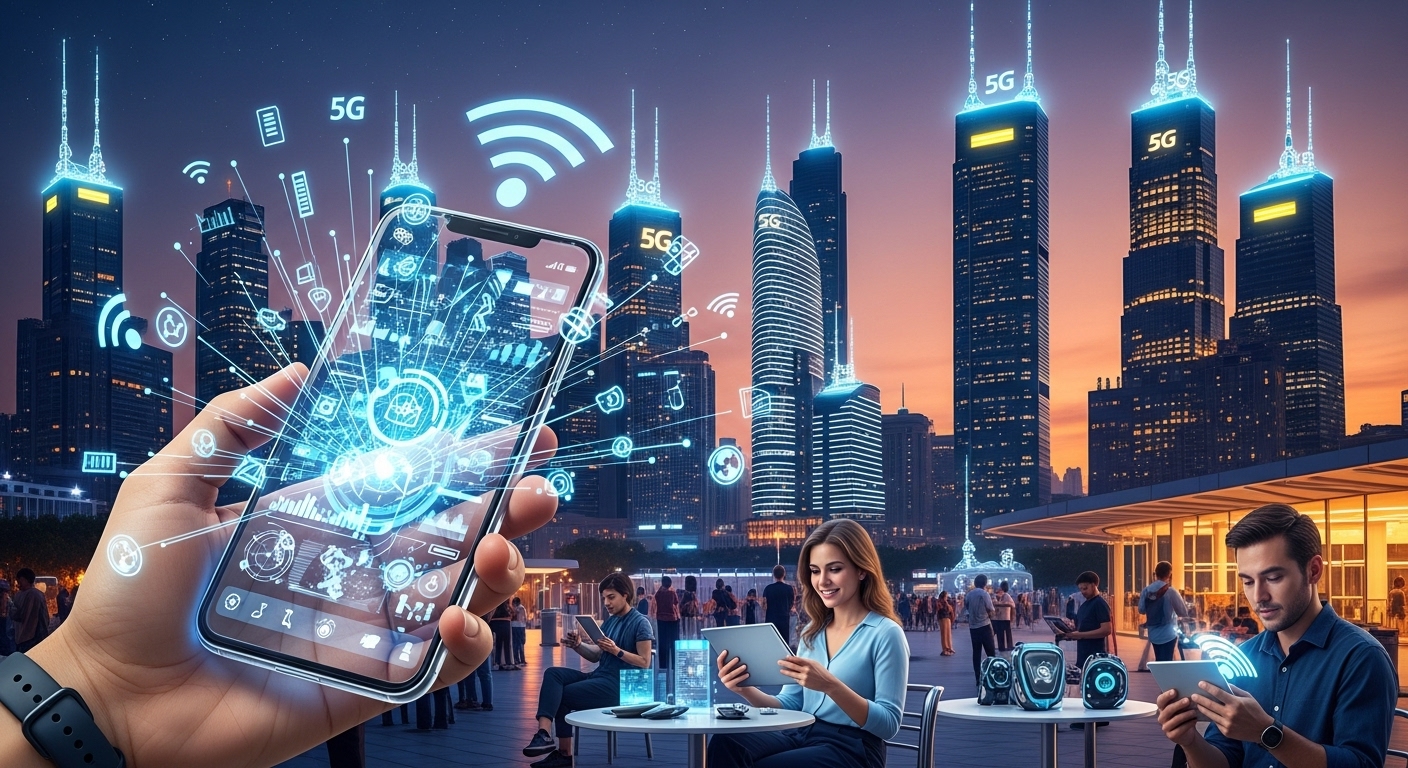- Posted on
- • Technology
How 5G Is Transforming the Way We Connect
- Author
-
-

- User
- FilesRename
- Posts by this author
- Posts by this author
-

How 5G Is Transforming the Way We Connect
Introduction
The arrival of 5G technology has been one of the most anticipated technological leaps of the decade. Unlike its predecessor 4G, 5G doesn’t just mean “faster internet.” It represents an entirely new ecosystem of connectivity, designed to power smart cities, autonomous vehicles, advanced healthcare, and real-time cloud gaming. In 2025, we are starting to see the real impact of this new mobile standard, and it is changing how we live, work, and interact with technology.
The Evolution of Mobile Networks
To understand the importance of 5G, it helps to look back. Each mobile generation introduced something new:
- 1G (1980s) – Analog voice calls, expensive and limited.
- 2G (1990s) – Digital voice and SMS messaging.
- 3G (2000s) – Internet browsing, email, and early mobile apps.
- 4G (2010s) – High-speed mobile internet, video streaming, and social media dominance.
- 5G (2020s) – Ultra-low latency, high bandwidth, and connectivity for billions of devices.
Where 4G was about people, 5G is about everything. It is designed to connect not just smartphones, but also sensors, machines, and entire infrastructures.
What Makes 5G Different?
The promise of 5G lies in three core pillars:
- Speed – 5G can theoretically reach speeds up to 10 Gbps, around 100 times faster than 4G.
- Low Latency – Latency can be reduced to under 10 milliseconds, enabling real-time applications like remote surgery.
- Massive Connectivity – 5G supports up to 1 million devices per square kilometer, making it ideal for IoT networks.
These improvements open the door for innovations that were impossible with 4G. For example, cloud-based gaming without lag, cars communicating with each other on the road, or entire factories running on wireless automation.
How 5G Works
5G uses a combination of spectrum ranges to deliver its performance:
- Low-band spectrum – Wide coverage but slower speeds.
- Mid-band spectrum – Balance of coverage and speed, ideal for most urban areas.
- High-band (mmWave) spectrum – Lightning-fast speeds but shorter range, used in dense cities and stadiums.
It also relies on small cells, distributed antennas that bring signals closer to users, unlike the tall cell towers of previous generations. This allows for higher capacity and efficiency.
Applications of 5G in Daily Life
5G isn’t just about faster video streaming. Its impact is far broader:
- Healthcare – Real-time monitoring of patients, remote surgery via robotic arms, and faster transfer of medical data.
- Education – Immersive VR classrooms and remote learning without connection issues.
- Transportation – Autonomous cars that can “talk” to each other and to traffic infrastructure.
- Entertainment – Streaming movies in seconds and playing cloud-based games with no lag.
- Smart Cities – Energy-efficient lighting, connected utilities, and real-time traffic control.
Industries Being Transformed by 5G
Several sectors are already seeing the impact of 5G:
- Manufacturing – Smart factories with wireless automation and predictive maintenance.
- Agriculture – Drones and IoT sensors improving crop monitoring and irrigation.
- Retail – AR shopping experiences and seamless contactless payments.
- Finance – Faster and more secure mobile transactions.
Challenges and Criticisms
Like any new technology, 5G faces challenges:
- Infrastructure costs – Deploying small cells and new towers is expensive.
- Coverage gaps – Rural areas may not see 5G benefits for years.
- Battery consumption – Early 5G devices often consume more energy.
- Privacy and security – With more devices connected, the risk of cyberattacks grows.
Some concerns are also related to health, but according to organizations like the World Health Organization 🔗, current 5G exposure levels are safe within international guidelines.
5G vs 4G: Key Differences
While both provide mobile connectivity, 5G is on another level:
- Up to 100x faster speeds.
- 10x lower latency.
- Massive IoT connectivity (4G was not designed for billions of devices).
- Advanced network slicing (dedicated “slices” for specific applications).
Real-World Examples of 5G in Action
Countries like South Korea, Japan, and the U.S. are leading 5G adoption. For instance:
- South Korea – Nationwide 5G used in smart city projects and public transport.
- China – 5G in agriculture, enabling farmers to monitor soil and crops remotely.
- United States – Telecom providers partnering with hospitals for remote healthcare solutions.
These case studies prove that 5G is more than hype — it’s already transforming industries.
The Future: Toward 6G
Even as 5G is expanding, research into 6G has already begun. Expected by 2030, 6G could deliver speeds up to 1 Tbps and integrate AI at the network core. This future promises even more immersive technologies like holographic communication and real-time digital twins.
Conclusion
5G is not just an upgrade — it’s a revolution in connectivity. Its combination of speed, low latency, and massive device support is enabling innovations across healthcare, education, entertainment, and industry. While challenges remain, the impact of 5G technology in 2025 is undeniable. The way we connect is changing forever.
Do you think 5G has lived up to the hype? How has it impacted your daily life so far? Share your experiences in the comments below!
FAQ
- Is 5G safe? Yes. According to the International Telecommunication Union 🔗, 5G radiation is within safe exposure levels.
- Does 5G work everywhere? Not yet. Urban areas are prioritized, while rural areas may face delays in rollout.
- Can I use 5G on any phone? No. You need a 5G-compatible device.
- What industries benefit the most? Healthcare, manufacturing, gaming, and smart cities are among the top beneficiaries.
- Will 6G replace 5G soon? 6G is still in early research. Full rollout is expected around 2030.